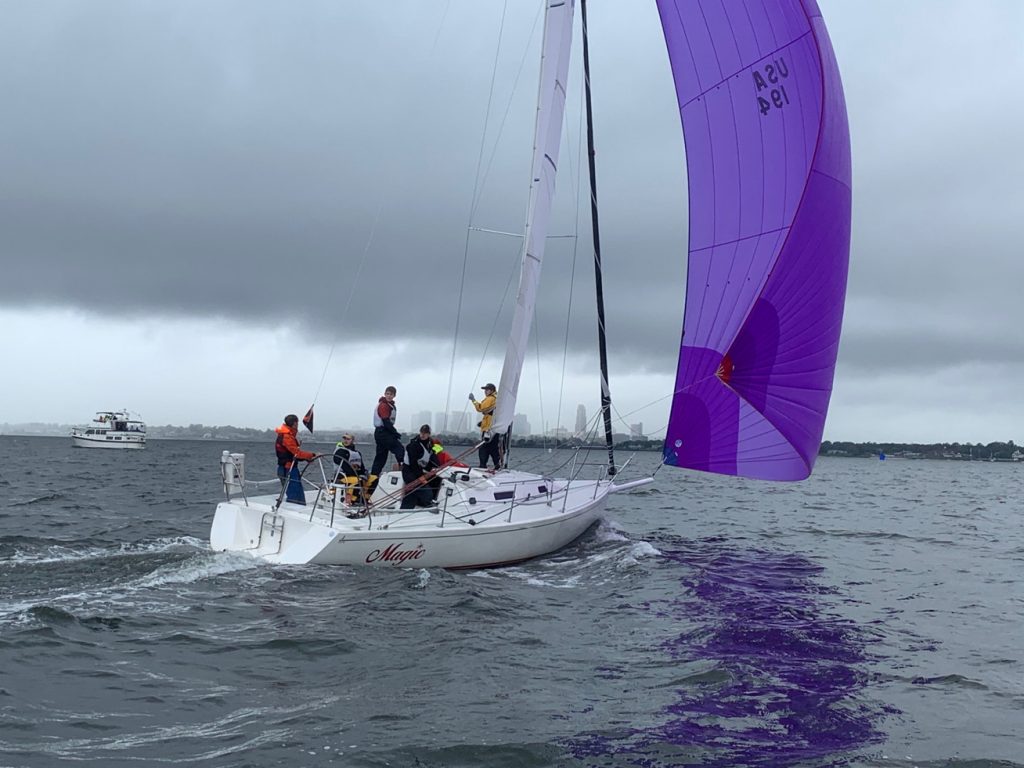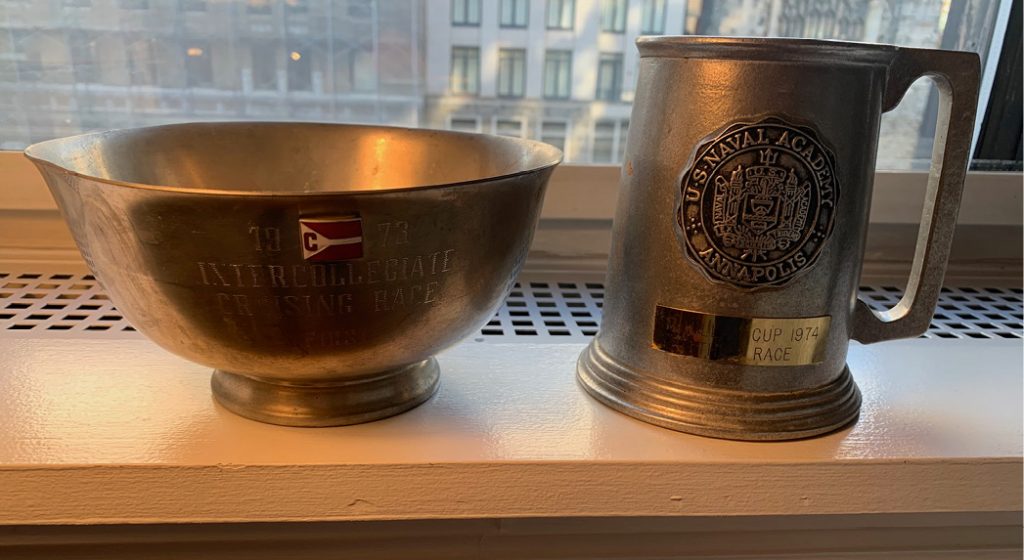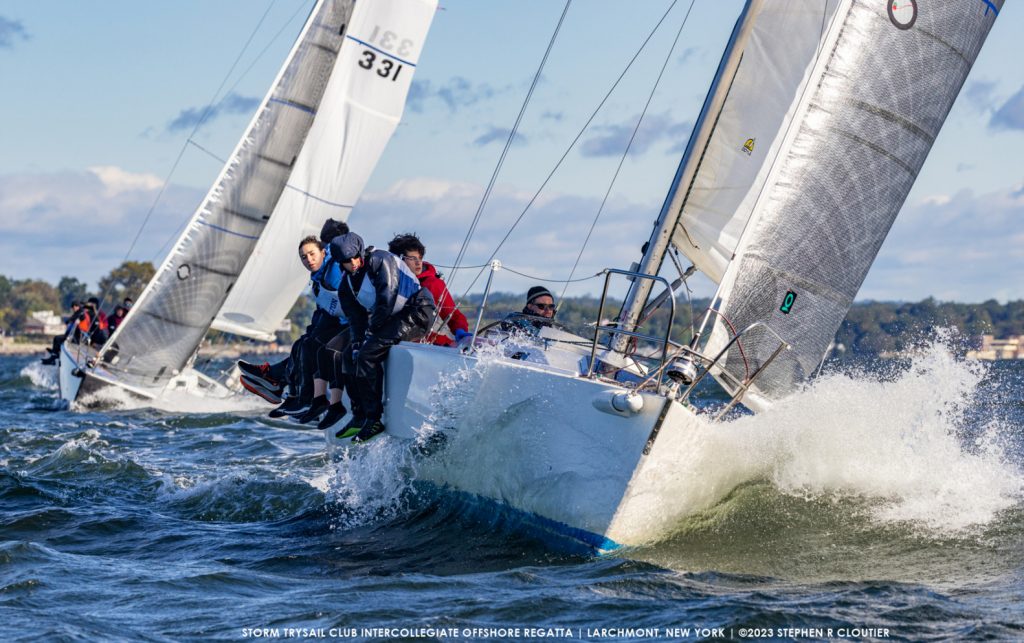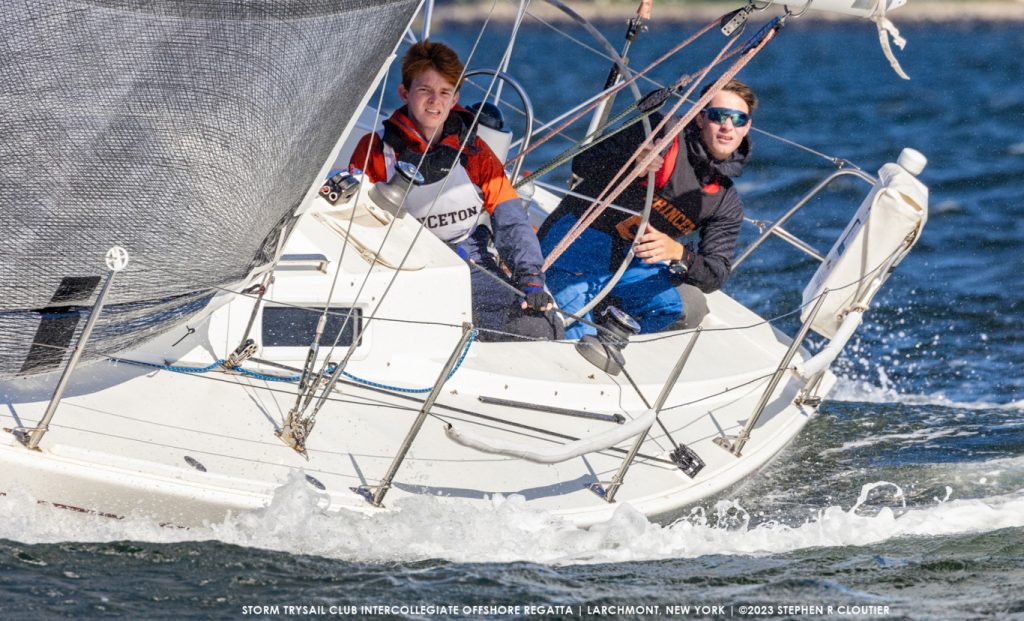Keelboat racing was the original form of intercollegiate sailing. From the McMillan Cup, first sailed in 1928 and formalized in 1930 as a quasi-national championship for college big boat crews, sprung a small number of spinoff events like the Kennedy Cup. Focused on the larger offshore keelboat fleets of the service academies, this form of intercollegiate big boat sailing was mega one-design competition.
In the 1970s, that offshore schedule expanded with events like the Corinthians, rebranded in the 1990 as today’s largest intercollegiate regatta, the Intercollegiate Offshore Regatta presented by ShopRite of Carteret (“IOR”), co-hosted by Storm Trysail Club and Larchmont Yacht Club in Larchmont, NY. With growth fostered by owners willing to lend their boats and go along for the ride as adult supervision, the college offshore circuit now has events in all parts of the country with more being added each year.
Today, intercollegiate offshore is the new thing for student sailors. As the informal advisor to my own alma mater’s offshore team, I’ve had the opportunity to see this interest blossom. The format featuring loaned boats coupled with expert race management from local host clubs like Larchmont and Charleston has led to more college big boat sailors. A surprising number of them had never been aboard an offshore boat before forming crews to race 40-footers ‘round the buoys.

Magic leads downwind on an unsettled Saturday at the 2023 Intercollegiate Offshore Regatta presented by ShopRite of Carteret.
Five Decades of College Offshore Racing: The Corinthians to the McMillan Cup
In 1973, as a junior at Princeton, I rounded up a half dozen of my sailing team friends, male and female, borrowed a 36-foot production PHRF boat and went to compete against a group of similarly rated boats. This was The Corinthians Regatta, sponsored by a local cruising sailing association. We won on corrected time on a clear, very windy October Saturday. Half of the crew was soaked in their dinghy gear – no boots, no gloves. Spirits were high, and the victory led to our competing in college offshore sailing’s Big Dance. That would be the 1974 McMillan Cup.

Two trophies for Princeton: The Corinthians, 1973 (left) and Race 3of the McMillan Cup, 1974
It was appropriate that the ‘74 Princeton Sailing Team would compete in that event. That McMillan Cup, dubbed the first college regatta, was held in 1974 at Annapolis under the auspices of the U.S. Naval Academy. That event had been dominated by Princeton crews in the early years. My own most prized trophy is still the pewter mug for winning the third race of the McMillan that fall.
In 1928, the McMillan began its odyssey through various venues in the Northeast in a hodgepodge of offshore keelboats, tracking almost a century of big boat college sailing.
Return to the New IOR
In 2023, a Princeton team – three female and three male – returned to the event once known as “The Corinthians,” renamed since the 1990s as the IOR. They sailed in the one-design J/105 class on a boat named Magic (#194) that had been delivered to Long Island Sound by her owners, Ann & Gary Myers, from Raritan Yacht Club in Perth Amboy, NJ. Raritan had been the base for the Princeton dinghy team from the early 1990s until Superstorm Sandy destroyed that location. In 2022, Princeton relocated its dinghy sailing to a location on the Delaware River closer to campus, but Raritan YC had continued providing a base for the offshore team to develop. During the summer season, student sailors joined local crews for the club’s racing schedule.
Ann & Gary Myer spearheaded this program, lending Magic for team practice. As IOR Co-Chair, Ann is a tireless advocate on the part of the Storm Trysail Club to engage young sailors. STC foots the bill for the event; participating teams sail free. Fleet sizes had been as high as 48 boats pre-pandemic. In 2023, 36 boats sailed in multiple classes. The largest block of boats is typically from the J Boats ranks, with 105,109 and 44 the largest one-design classes.
Gary Myer, a retired educator, was the perfect complement to a young crew with limited experience. This Tiger offshore team has a diverse background, as is fitting for a modern crew. This was the second IOR for the team, including helmsman Jasper Waldman, a sophomore from Canada who spent the summer of 2023 making sails for Doyle in Newport, RI, and bow person Virginia Cobbs from Birmingham, Alabama, who handled the wild conditions of the 2023 IOR nonplussed. The main trimmer everyone called Eddie had an unusual provenance for an Ivy League sailor; he came to college from the U.S. Coast Guard. He was literally the crew’s veteran. It was a typical collegiate big boat crew: eager, lightly experienced but ready to learn.
Gary is thoughtful about the mission of developing a fledgling college crew. He observes, he encourages and re-encourages. The IOR Sailing Instructions stipulate he cannot pull the strings nor give exploit coaching. The technical term for Gary’s role is Safety Officer and those “SOs” could be heard throughout the day, providing guidance for fast-gelling crews.
“When we were going to the finish, I just kept saying, ‘Down. Drive the boat fast, and keep it down.’” said Gary. “We were able to build a nice lead, despite the breakdown.” (Team Magic broke their jib halyard midway through the action on Sunday, improvising for the last two races to hold on to the top position in class.)
IOR ’23 was challenging, with a windless Saturday morning giving way to a 12-knot southerly and then to a blinding line squall which suspended racing for the day after one race. Sunday dawned clear, windy and cool, a typical Long Island Sound northwesterly cold front. Spinnakers were banned on Sunday after Saturday’s squalls had produced some kite shrimping.
Jasper Waldman, the Princeton driver, was thrilled with their top-of-the-podium finish. “Two thirds of the team had never raced a sailboat before arriving at Princeton, but we’ve been able to foster a strong team culture entered around communication. This served us tremendously, keeping morale high in the rain, and bouncing back from breakages, allowing me to focus on driving the boat fast.”
When the boats were put away and the traditional IOR post-race pizza party had commenced, the verdict from student sailors was unanimous: “Great! Can’t wait to come back next year.” A complete recap of the 2023 IOR by Kate Somers (with a fantastic gallery by Steve Cloutier) is online at
stormtrysail.org/ior-2023-recap/
McMillan: From Metre Boats to One-Design Offshore
How did we get here, almost a century after the first McMillan Cup? What is the creation story of college big boat competition? First there were only big boats, then came little boats; college sailing’s story starts in the 1920s.
If you reread our WindCheck story on Six Metre sailing in the early 20th century (or our Conversations with Classic Boats podcasts), you’ll find that informal collegiate sailing competition dates back to the establishment in 1921 of the British American Cup. That fiercely competitive series between American and English Metre boat designs produced a fleet of well over fifty 6 Metres as well as numerous 8 Metres to be drawn on for use in student competition.

The co-ed Offshore Tigers posted a 2-1-1 scoreline to top the event’s J/105 One-Design Class. © Stephen R Cloutier
The earliest collegians who competed in sailing, like Briggs Cunningham at Yale (Pequot YC in Southport, CT) and Arthur Knapp at Princeton (Larchmont YC), found these modern keelboats ideal for challenging their Ivy opponents.
The records of college sailing document the early regattas, of which the McMillan Cup is deemed to be the first. Housed at Mystic Seaport Museum, those archives contain the files and notes on the development of early college sailing in the 1920s.
We know from the archives of the Princeton Yacht Club, founded in 1928, that the 1920s action was in keelboats.
This was college sailing years before the introduction of one-design collegiate dinghies like MIT’s Tech Dinghy or Olin Stephens’ Interclub Dinghy, a frostbiting design widely adopted by post-war college teams. The early archives talk about bigger boats in the wake of elite college skippers commandeering local Metre boats for pick up match racing. Dinghy sailing followed.
John Rousmaniere, noted sailing historian, wrote a foreword for the archives and I quote directly from excerpts in the ICYRA file:
“Intercollegiate racing traces its origin to the founding of yacht clubs and sailing associations in the late 19th century. Yale, Harvard, MIT and Brown were early clubs. Activity was limited to occasional “pick up” races in summer months between private yachts with many prestigious owners…
“Arthur Knapp, Princeton ’28, was the organizer of the first intercollegiate race series, held in 8 Metres at Pequot Yacht Club in June, 1928. Princeton beat Yale and Harvard, winning the George May Trophy. Sherman Hoyt, a Brown alumnus, was ever present in arranging for the borrowed boats in the ‘30s. From this beginning, the ICYRA has grown mightily….
“The first college fleet was established at Princeton in 1934 and the first intercollegiate dinghy series occurred on Lake Carnegie in Tiger class dinghies, between Princeton and Dartmouth. As frostbiting became popular, an intercollegiate regatta was held at Manhasset Bay in Dyer dinghies in 1935….
“The Intercollegiate Yacht Racing Association was formed June 16, 1930, during the annual series raced for years in sloops borrowed at various East Coast yacht clubs. The McMillan Cup, a perpetual trophy, was presented in 1931, to replace the May trophy retired with Princeton’s third victory. This three and done rule was modelled on the British American Cup. Their rule was with three wins, you get the trophy; Princeton won 1930 and ‘31, and 1935 and ‘36 after their initial 1928 wins in the McMillan.

Princeton helmsman Jasper Waldman led the team to victory. © Stephen R Cloutier
“The sport really owes continuing growth to the establishment of dinghy racing at MIT in 1936 when the Sailing Pavilion and thirty-six Herreshoff-built dinghies, designed by MIT’s professor George Owen, were launched…
The participation of the Naval Academy and the Coast Guard Academy assured the continuation of college racing during WWII along the East Coast. The simultaneous growth of the sport in California, Hawaii and the Northwest was assured by the founding of the ICYRA; there in 1940 greatly abetted by the activity of Bob Allan, Stanford ’39. The present Intercollegiate Yacht Racing Association was incorporated in 1949 and continues to this day with over 200 colleges with sailing fleets.” (Today, there are well over 300 collegiate fleets.)
Source: ICYRA archives, Mystic Seaport Museum
The McMillan: All Roads Lead to Annapolis
At the time the Roaring ‘20s were peaking, a Baltimore gentleman named McMillan commissioned a Tiffany trophy for a competition to be held initially at the Naval Academy at Annapolis. The McMillan Cup has evolved over generations of college sailing. Up to 1950, the regatta was held at various sailing venues in New England (Marblehead, Newport and others). After WWII it became apparent that the competing colleges would have difficulty obtaining sufficient boats to hold the MacMillan. In 1950, the Naval Academy offered their 44-foot Luders yawls for competition. Since then, this has been a Chesapeake Bay event in government owned craft. Racing went right through WWII. Only two years have been skipped since inception; for pandemic in 2020 and back in 1991, reason unknown.
Who won at the beginning of the McMillan? The first ten winners before WWII were in chronological order Princeton, Princeton, Cornell, Dartmouth, Harvard, Princeton, Princeton, Yale, Harvard, and Williams. In 2023, Kings Point put on a late surge to take the cup after Rhode Island won it in 2022. An examination of the last fifty regattas shows the Naval Academy with the most wins, not surprising given their home court advantage.
The Future of College Offshore is Growth
Take a look at the college sailing calendar. It looks like an urban train schedule; there is a lot going on. Collegiate sailing coaches manage programs dense with events, ranked by levels and formats: co-ed, team race, etc. The quest for a national dinghy championship is all in the running up the points to earn participation in the year-end events. For the college offshore team, there is no such path. They do it because they enjoy it. The camaraderie of working with a team, of mastering new skills, has its own rewards.
What does the Princeton team have on their docket this season.? With the IOR win in their pockets, they hope to travel twice more to compete this season. In March they travel to the new sailing mecca of Charleston, then (weather and school schedule permitting), they take their first trip to the Great Lakes Championships in Chicago. ■
Not a formally trained historian nevertheless a boat storyteller, collecting and reciting stories for the boating curious, Tom Darling is the host of Conversations with Classic Boats, “the podcast that talks to boats.” Tune in via Apple Podcast, Google Podcast or Spotify, or online at conversationswithclassicboats.com.
